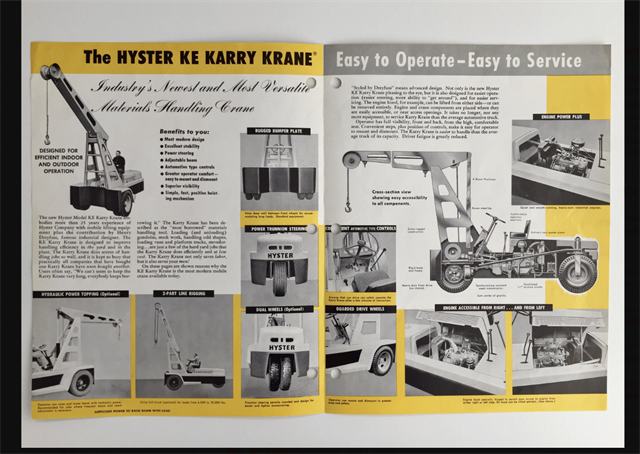 The Karry Krane at Public Steel that won the oldest running Hyster forklift competition
The Karry Krane at Public Steel that won the oldest running Hyster forklift competition
Recently, Intella Parts Company ran a little competition for its customers to find the oldest running Hyster forklift. The winner was a real "doozy", a still operational Hyster Karry Krane submitted by Public Steel of Amarillo Texas. So, I figured this sparks a good opportunity to dive into some Karry Krane history.
Take a look at the photo and you will notice that to modern forklift operators and drivers, this model of Hyster looks a little strange. To explain Intella delves into the forklift history books, 'this truck was built and designed in the era before the modern pallet was invented. Back in the 1940s, pallets weren’t really universally used, and the Karry Krane was a sort of pre-cursor to the modern forklift which lifts the omni-present 48×48-inch pallet. “Forklifts” of this time were just used as universal “move stuff around the factory” pieces of equipment.'
The Karry Krane was originally called a Cranemobile as it was essentially a mobile crane on a tractor frame. The original Karry Kranes from the late 1930s and 1940s were most likely built in their Peoria IL factory which was responsible for the production of winches and cranes for use as tractor equipment.
The Karry Krane was such a versatile piece of equipment in fact that apparently it played a major role in the WWII war effort internationally with the Allied forces relying on the trucks at shipbuilding facilities, in ports for cargo handling and after the war for rebuilding efforts.
 Image sourced at https://portsidenewyork.org/
Image sourced at https://portsidenewyork.org/
According to Encyclopedia.com, almost 1,000 Karry Kranes were used during the war, ‘setting an important precedent for the international expansion that Hyster was to undertake in the late 1940s and 1950s.’
In fact, when Hyster opens its first plant outside the US in 1952 in Nijmegen, the Netherlands, the Karry Krane is assembled there.
Here's an original brochure for the Hyster KE Karry Krane manufactured from 1956, shared by Hyster Europe on their Twitter page. ‘Styled by Henry Dreyfuss’ Hyster proclaimed it to be ‘the industries newest and most versatile materials handling crane.’

 Original brochure shared by Hyster Europe on Twitter
Original brochure shared by Hyster Europe on Twitter
According to Phillip DeLuna from Public Steel their Karry Krane still runs, and it even gets used (once in a while). Well, I suppose that makes sense since I did read in the brochure that ‘once you use a Hyster Karry Krane you will never again be without one.’
 The Karry Krane still runs and it even gets used (once in a while) at Public Steel of Amarillo Texas
The Karry Krane still runs and it even gets used (once in a while) at Public Steel of Amarillo Texas
Have you got more to add to the Hyster Karry Krane story? Let me know. Or share your forklift histories and throwbacks with us here.